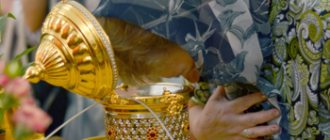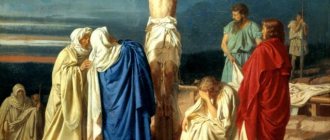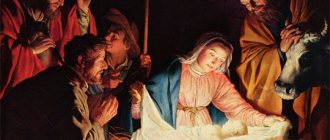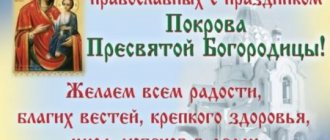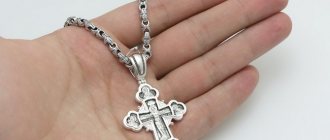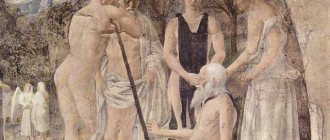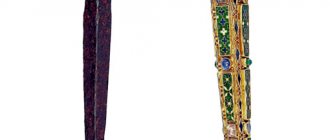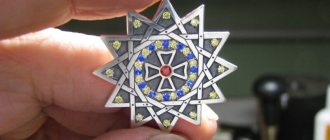The word NIKA (victory)
symbolizes Christ's victory over death, His resurrection.
The inscription on the cross ICXC
is
Jesus Christ the King of Glory
.
~
sign located above the letters indicates abbreviation of words.
An eight-pointed cross was first depicted in a hand-drawn miniature in the work of the Greek monk Anastasius Sinaita (VI-VII centuries). The upper crossbar symbolizes the titlo - the tablet on which Pilate inscribed: Jesus of Nazareth, King of the Jews ( INCI
). Hands are nailed to the middle crossbar. The lower beveled crossbar symbolizes the footstool on which Christ's feet rested. This crossbar (especially in Rus') is attributed with a special symbolic meaning. Two thieves were crucified together with Christ. One slandered Jesus, while the other, on the contrary, calmed him down and said: “... we were condemned justly, but He did nothing wrong.” The prudent robber confessed his guilt and asked the Lord to forgive him for all his sins. And Jesus said to him: “Truly I tell you, today you will be with Me in Paradise.” Thus, this crossbar is a symbol of the scales of God’s judgment, which through repentance raises one to heaven and casts (the unrepentant thief) into hell. This miniature later became the prototype of most Byzantine and Russian Crucifixions. The idea of the Resurrection was conveyed on crosses through the image of a skull (the head of Adam) at the base of the cross (sometimes next to the letters GA). The Fathers of the Church call Christ the New Adam, who atoned for original sin - “The blood of Christ washed away the sin of Adam.” Therefore, the image of Adam’s head under the cross speaks not only of his fall and death, but also of his redemption by Christ and resurrection.
Cross-anchor and cross-letter: early Christianity
The path of the cross to the status of the main symbol of Christians was long and thorny.
In the first centuries of Christianity in the Roman Empire, other symbols were much more common - a lamb or a shepherd with a lamb - a symbol of the Savior or Jesus and his flock; loaves and fishes - those that Christ miraculously multiplied; a bird with a branch in a key or a laurel wreath are symbols of resurrection; fish or fishes - because the ancient Greek word "ichthus" ("fish") was used by Christians as an acronym for the Greek words "Jesus Christ, Son of God, Savior." Scientists find these symbols in the catacombs, burial places of Christians, where meetings and prayers were also held. It is worth dwelling on ichthus in more detail.
Firstly, the fish or dolphin itself could personify Christ - believers often drew an anchor nearby, and sometimes an anchor or trident even pierced the body of the animal. In this way, Christians portrayed Jesus without depicting him, referring to the execution on the cross without demonstrating its shameful details.
Secondly, the fish was often depicted graphically, in the form of two semicircles containing inside the monogram of Christ, the same ichthus. Ichthus was not the only encryption of the Savior's name - the name is often represented in other monograms using or combining the initial letters of his name. Among them are the Greek letter Chi, chrisma (Chi and Rho), IX-monogram (Iota and Chi), as well as the staurogram (Tau and Rho).
Some scholars suggest that the Romans considered death by crucifixion shameful, since only slaves and non-citizens were doomed to it, and therefore did not want to depict this scene literally. Thus, several ways appeared to hide the cross behind symbols that referred to its shape. In Antiquity, torture crosses were close to a T-shape, so the staurogram referred to a real wooden crucifix, familiar to everyone at that time. This monogram has been used in manuscripts since at least the 2nd century.
A cross in the form of the letter X or a combination of I and X could be reminiscent of the crucifixion as an event of cosmic significance, since early Christians associated the image of this letter with Plato's description. According to the dialogue Timaeus, God created the world by folding “both parts crosswise like the letter X.”
Emperor Constantine saw the sign of the cross in the sky on the eve of an important battle in 312. So he introduced the use of the Chi Rho monogram as a military standard, a labarum vaguely reminiscent of a cross, and banned execution by crucifixion. According to legend, in 326, Constantine's mother, Queen Helena, discovered the real crucifixion of the Lord. After this event, it was the cross - and not the monograms of Christ or allegories - that finally became the main symbol of Christianity. The symbolism of the cross began to be seen in the evidence of long-gone eras, for example in the Old Testament: the theologian Clement of Alexandria suggested that the number 318 mentioned in the Book of Genesis correlated with the numbers of the cross (300) and Christ crucified on it (18), thus acting as an omen . However, in Rome it came to the adoption of Christianity as the official state religion only in 380.
The Executed Donkey: Crucifixions of Late Antiquity
The first literal, rather than allegorical or graphic, depiction of the crucifixion of Jesus on the cross did not come to us from a Christian source. In the so-called graffito of Alexamen, created in Rome around the 1st–3rd centuries, we see a parody of Christian images. The man named Alexamen in the inscription stands in front of the Savior crucified on the cross with the head of a donkey. This strange travesty is due to the fact that many non-Christians at the time were convinced that Christians actually worshiped a donkey.
Roman intellectuals believed that Christianity was a “low, crude superstition” and described how the followers of Jesus, in addition to the donkey, worshiped graves, the sun and the phalluses of priests.
The fact that all these statements are not an invention of later authors is evidenced by the statement of the Roman theologian of the 2nd–3rd centuries Tertullian, who answered his opponents: “some of you dreamed that our God is the head of a donkey.” Tertullian also had to prove that Christians do not deify the gallows or worship the cross. At the same time, he mentioned that Christians of his era painted crosses on their foreheads or chests to protect themselves from demons.
The Romans' belief in the donkey-likeness of Jesus could have come from the episode of the solemn entry of the Son of God into Jerusalem riding on a donkey. In addition, the Romans for the time being considered Christians to be no different from the Jews, and Greek and Roman historians repeatedly accused the Jews of worshiping a donkey in the Jerusalem temple. In the first centuries of Christianity, the ancient view was still widespread: some parts of a person’s body, when he copulated with an animal, allegedly turned into parts of the body of that animal. Opponents of Christianity ridiculed Christ, believing that since his followers worshiped a donkey, it was he himself, who became so as a punishment for his bestiality. A parodic allusion to Jesus' copulation with a donkey is contained in Tertullian's description:
“One of those hired to fight animals exhibited a picture with the following inscription: DEUS CHRISTIANORUM ONOKOITHS - “The Christian God is a degenerate donkey.” On it He was depicted with donkey ears, with a hoof on one leg, with a book in his hand and with a toga on his shoulders. [The crowd] laughed at both the inscription and the image.”
Around the same time, in the 2nd and 3rd centuries, several intaglios and gems ((semi) precious stones with carvings) were created showing the crucifixion of Christ. The main problem with these images is that gems were usually used by those who wanted to protect themselves with their magic, and this does not fit well with Christian theology. The gems were carved with images of not only Christ, but also incredible beast-headed gods, called upon to protect the owner. Therefore, historians believe that this image was used more as a protective amulet than as an object of worship for Christians. This is also evidenced by the magical inscriptions inscribed behind the crucifix:
“O Son, Father, O Jesus Christ, soam noam oaoi, AEEIOYO, O cross [s]y[on] the redeemer!”
“Ioe eua eue ioui, you are Iadetofot Iesebteke Emanauel Astrapekmef Meito Armempe.”
Strange vowel combinations are not nonsense. Magi in the Roman Empire, following the followers of Pythagoras, believed that the seven Greek letters representing vowels were associated with the mystical-religious Pythagorean theory of the harmony of the spheres bearing the planets. The letters symbolized the seven notes that the seven planets sounded as they rotated across the sky. However, man was not given the opportunity to hear the celestial harmony composed of planetary notes (although the Pythagoreans believed that their teacher was capable of this, and Kepler in the 17th century argued that the harmony of the spheres could be heard by the soul).
In a number of Greek magical papyri or on papyrus amulets, scientists find spells containing groups of letters denoting the seven Greek vowels: α, ε, η, ι, ο, υ, ω (a, e, e, i, o, y, o) . Sometimes they form almost unpronounceable palindromes: ιαωαωιωιααιωιωαωαι (iaoaoioiaaaioaoaai). The letters and their sequences served as symbols of celestial music: each planet corresponded to a certain note, and that, in turn, corresponded to one of the seven vowels of the ancient Greek language. In Ancient Greece there were no numbers, letters were used instead, so each vowel is also a number. Vowels were not an earthly reflection of heavenly sounds, they were numbers, through mental contemplation of which the essence of the deity appeared to the priests. Magicians in the Roman Empire believed that these vowels had to be spoken mentally in a certain sequence in order to produce a certain magical effect. They could be written down on something that a person constantly carries with him, so that this effect would be permanent on him.
Thus, the crucified Jesus appeared on a magical amulet - for Roman magicians he was just one of the deities to whom they considered effective invocations.
It is also possible that this amulet was used by people who were leaning toward Christianity (including unorthodox) or even considered themselves Christians. However, today it is difficult to prove which of the three options is correct due to the lack of other sources.
FAQ:
Is it possible to wear a small icon and a cross on the same chain?
Can. There are no restrictions on this matter.
Is it necessary to consecrate the chain?
There is no special rite for consecrating the chain, but it is good to give it to the priest along with the cross - he will sprinkle it with holy water. If you buy chains in a temple store, then, as a rule, the chains are already consecrated.
What should a pectoral cross be like according to church canons?
This question requires a very common answer. In order not to delve into the jungle of symbolism and history of the Church, we can simply assure that all the crosses that you will find on this site are canonical.
Is it possible to get a small cross tattoo?
It’s worth figuring out why you need such a tattoo and what you expect from it. If you want it to replace the pectoral cross, then this is impossible. In general, the Holy Fathers speak very strictly about images on the human body, at best not recommending their application.
Where to put a blackened or broken cross?
The main thing to focus on in this matter is that the image of the Cross should not be trampled upon in any way, which means that it should not be thrown away with the slop under any circumstances. It is best to give the cross or icon to the nearest church. It is also worth noting that blackened silver can be easily wiped off with specialized products, and sometimes with plain soda. Also, crosses made of precious metals can be re-melted.
The cross accompanies a Christian throughout his life. We see crucifixes in churches, at home, and wear them on our chests. And yet many questions arise. Let's try to figure out what the details of the cross in the images mean. The top crossbar symbolizes a tablet with an inscription made by Pontius Pilate, the Roman emperor's governor in Judea. In Hebrew, Greek and Roman it was written: “Jesus of Nazareth, King of the Jews” (John 19:19-20). When depicting the Crucifixion, the abbreviation I.H.C.I is usually used. (I.N.C.I.). The lower crossbar is the footstool to which the Savior’s feet were nailed.
The letters “K” and “T” to the left and right of the Cross represent passionate weapons: a spear and a cane. The tools themselves are usually depicted along the Cross. “There was a vessel full of vinegar. The soldiers filled a sponge with vinegar and put it on hyssop, and brought it to His mouth” (John 19:34). “But one of the soldiers pierced His side with a spear, and immediately blood and water flowed out” (John 19:34). The crucifixion and death of Jesus were accompanied by menacing phenomena: an earthquake, thunder and lightning, a darkened sun, a crimson moon. The sun and moon are also sometimes included in the composition of the Crucifixion - on the sides of the larger crossbar. “The sun turned into darkness, and the moon turned into blood...”
The elevation on which the Cross stands symbolizes Mount Golgotha, on which the Crucifixion took place. The Hebrew word "Golgotha" means "forehead" or simply "skull." The abbreviation “GG” just means “Mount Golgotha”, and “MLRB” means “the place of the frontal paradise”. The cross, on which the Savior of the world offered the Redemptive Sacrifice, opened the gates of heaven, which were closed after the Fall of Adam. Therefore, the Place of Execution (Golgotha) became paradise. This thought found expression in the church hymn: “The place of the forehead became paradise: for the tree of the cross was erected, and the grapes of life were to grow” (Octoechos, tone 5. On Wednesday morning, according to the 1st verse, saddle crosses). According to legend, the first man, Adam, was buried on Golgotha, considered the center of the Earth. “As in Adam all die, so in Christ all will come to life, each in his own order: Christ the firstborn, then those who belong to Christ...” “HA” is the head of Adam. Therefore, in a symbolic break, in the bowels of Golgotha (or without a break, simply at the foot of the Cross), the ashes of Adam, indicated by a skull, are depicted. By the way, here they often write together: GGGA - “Mount Golgotha is the head of Adam.”
Jesus is depicted with a cross-shaped halo, on which three Greek letters are written, meaning “the one who truly exists,” as God said to Moses “I am the One” (I am the One) (Ex. 3:14). Above the larger crossbar is written in abbreviation, with abbreviation signs - titles, the name of the Savior “IC XC” - Jesus Christ, below the crossbar is added: “NIKA” (Greek - Winner).
Large multi-figure compositions of the Crucifixion are a topic for separate consideration. Most often, the Mother of God and John the Evangelist are depicted at the Cross; in more complex compositions, weeping wives and the centurion Longinus are added. Two weeping angels are often depicted above the Cross. Warriors with a cane and a spear can also be depicted; warriors are sometimes shown in the foreground, drawing by lot the clothes of the Crucified One. A separate iconographic version of the composition - the so-called. "Crucifixion with Thieves", which depicts three figures crucified on crosses. On both sides of Christ are two robbers: one with his head bowed, the other with his head turned to Christ, the same prudent robber to whom the Lord promised the Kingdom of Heaven.
In Orthodoxy, a six-pointed crucifix is considered canonical: a vertical line is crossed by three transverse ones, one of them (the lower one) is oblique. The upper horizontal crossbar (the shortest of the three transverse ones) symbolizes a tablet with an inscription in three languages (Greek, Latin and Hebrew): “Jesus of Nazareth, King of the Jews.” This tablet, by order of Pontius Pilate, was nailed to the Cross of the Lord before the crucifixion.
The middle crossbar, shifted closer to the top (longest), is a direct part of the Cross - the hands of the Savior were nailed to it.
The lower oblique crossbar is a support for the legs. Unlike Catholics, in Orthodoxy on the Crucifixion both legs of the Savior are shown pierced by nails. This tradition is confirmed by studies of the Shroud of Turin - the cloth in which the body of the crucified Lord Jesus Christ was wrapped.
It is worth adding that the oblique shape of the lower crossbar carries a certain symbolic meaning. The raised end of this crossbar rushes upward to the sky, thereby symbolizing the thief crucified at the right hand of the Savior, who, already on the cross, repented and entered with the Lord into the Kingdom of Heaven. The other end of the crossbar, facing down, symbolizes the second thief, crucified on the left hand of the Savior, who blasphemed the Lord and did not receive forgiveness. The state of this robber’s soul is a state of God-forsakenness, of hell.
There is another version of the Orthodox Crucifixion, the so-called full or Athos cross. It carries even more symbolic meanings. Its peculiarity is that certain letters are inscribed above the canonical six-pointed Cross.
What do the inscriptions on the cross mean?
Above the topmost crossbar is inscribed: “IS” - Jesus and “XC” - Christ. A little lower, along the edges of the middle crossbar: “SN” - Son and “BZHIY” - God. There are two inscriptions under the middle crossbar. Along the edges: “TSR” - King and “WORDS” - Glory, and in (translated from Greek - victory). This word means that with His suffering and death on the Cross, the Lord Jesus Christ conquered death and atoned for human sins.
On the sides of the Crucifixion are depicted a spear and a cane with a sponge, designated, respectively, by the letters “K” and “T”. As we know from the Gospel, they pierced the Lord’s right rib with a spear, and they offered Him a sponge with vinegar on a cane in order to relieve His pain. The Lord refused to alleviate His suffering. Below, the Crucifixion is depicted standing on a base - a small elevation, which symbolizes Mount Golgotha, on which the Lord was crucified.
Inside the mountain is the skull and crossbones of the forefather Adam. In accordance with this, on the sides of the elevation there is an inscription - “ML” and “RB” - Place of Execution and Crucified Byst, as well as two letters “G” - Golgotha. Inside Golgotha, on the sides of the skull, the letters “G” and “A” are placed - the head of Adam.
The image of Adam's remains has a certain symbolic meaning. The Lord, being crucified, sheds His blood on the remains of Adam, thereby washing and cleansing him from the fall he committed in paradise. Together with Adam, the sins of all humanity are washed away. In the center of the crucifix there is also a circle with thorns - this is a symbol of the crown of thorns, which was put on the head of the Lord Jesus Christ by Roman soldiers.
Ankh on the icon and the monogram of the Trinity: crosses of the early Middle Ages
Crosses - not yet free from the influence of the form of the ancient monograms of Christ - existed in the mosaics of late Antiquity and the early Middle Ages. The mosaic from the baptistery of the cathedral of the Italian city of Albenga dates back to the second half of the 5th century. It schematically depicts the Trinity in the form of a triple repetition of the chrism (monogram of Christ Chi Rho). The threefold repetition of the Greek letters Alpha and Omega denotes the power of the Lord. The first and last letters of the Greek alphabet are mentioned in the Bible verse: “I am Alpha and Omega, the beginning and the end, the First and the Last” (Rev. 22:13). Twelve doves sitting around are symbols of the twelve apostles, the founders of the Christian church on earth. Doves will appear on other monuments of Italian art, such as the 12th-century cross in a mosaic in Rome's Basilica of St. Clement.
A mosaic of similar style from the Roman Basilica of Santa Pudenziana, created around 385, no longer shows a chrysism, but a real cross decorated with precious stones. On the mosaic of 549 from the Ravenna basilica of Sant'Apollinare in Classe, in the center of the precious cross there is an image of the Savior.
On the first icons that have come down to us, which today are kept in the monastery of St. Catherine on Mount Sinai, crosses are in the hands of saints, apostles and the Savior himself (the crucifixion is depicted in the Holy Scriptures).
Just by the way the cross is organically integrated into the narrative of mosaics and icons, it is obvious that by the 4th–6th centuries the crucifixion had become part of the Christian liturgy. Some researchers see continuity between the main Christian religious symbol and the ankh,
a symbol of eternal life in the Egyptian tradition (later it would be borrowed by the Copts and become one of the variants of the cross in Africa).
Indeed, some of the Fayum portraits—painted funerary plaques that were attached to sarcophagi containing mummies and first discovered in the region near modern Cairo—have images very similar to those we see in early icons. For example, some portraits dating from the 3rd–4th centuries show women holding the ankh in exactly the same way as the saints on the Sinai icons.
Fayum portraits with icons are similar in material (wooden tablet) and encaustic technique (paint on wax). Probably, Egyptian images could become a prototype for the compositional solutions of the icon, and some details could migrate from polytheistic images to Christian ones.
The importance of the crucifix as a universal symbol of Christianity in late Antiquity is, of course, confirmed by surviving artifacts. Among the earliest crosses made of metal are the so-called crux gemmata
, that is, gold crucifixes decorated with precious stones. We saw one of them on the mosaic above, and the oldest such cross that has come down to us dates back to the end of the 6th century. In the same century, images of Christ crucified on the cross appeared, no longer in parodic or magical contexts. However, this is another story - the scene of the crucifixion of the Lord was one of the most important pillars of Christian iconography and deserves a separate article. In this one we will only talk about the cross as a symbol of crucifixion, as well as its various forms.
National crosses: from Africa to the Basque Country
While in the first centuries of our era crosses or their prototypes occasionally appeared on frescoes in catacombs, sarcophagi, mosaics and some coins or gilded ends, in late Antiquity they became part of the liturgy and an integral - and most important - part of Christian iconography. It is not surprising that a huge number of forms of the cross arose. The very first of them were:
crux quadrata
, or Greek cross;
crux immissa
, or Latin cross;
Variations of it include the inverted cross of St. Peter, as well as the archiepiscopal cross—and the papal cross—used in Catholic liturgy. The papal cross, triple, like the papal tiara, is a symbol of the Trinity and distinguishes the pope from other clergy. Accordingly, the archiepiscopal cross demonstrates that the archbishop is one step lower in rank.
crux commissa
, or Tau cross;
crux decussata
, or St. Andrew's Cross.
Most theologians believed that Christ was crucified on a Latin cross, although some suggested that it was still a Tau cross. The diversity of opinions is also evidenced by various assumptions that the Savior was hanged and not crucified on the cross. For example, in the hymn of Venantius Fortunatus “The Banners Are Coming to the King” (VI century), when describing the crucifixion of Christ, instead of the word “crucified” there is the word “suspended”:
The banners are approaching the king, And there the mystery of the Cross will shine, Where in the flesh the one who created us was suspended by our enemies.
The four main forms of the cross were used in liturgy, church decoration and heraldry. Due to the active use of the symbol throughout Christendom, many artists tried to create more and more intricate forms, thus distinguishing their crosses from others.
So the cross acquired countless “national” variants. In the 3rd century, among the Copts living in the territory of modern Egypt, a cross, going back in shape to the ancient Egyptian ankh, spread.
In Armenia, the first country to adopt Christianity (301), the cross became a figurative cross.
It was with such decorations along the edges that sculptors depicted the crucifix on stone khachkar crosses. They probably meant living leaves sprouting from the dead tree of the cross, hinting at the resurrection of the Savior. In Georgia, Christianity was adopted in 326; according to legend, Saint Nina convinced the king to baptize the country. The Georgian variation of the cross is associated with the legend that the Mother of God appeared to St. Nina and handed her a cross woven from a grapevine.
This explains its unusual shape and at the same time makes it similar to the Armenian cross with pronounced plant motifs. In Caucasian Albania, neighboring Armenia, where Udin Christians lived (in this country they adopted Christianity after Armenia - in the 330s), the cross was also similar to the Armenian one.
On modern Udi crucifixes there are also symbols of the Moon and the Sun (often present on Orthodox icons or Catholic altar panels).
The second wave of baptisms in European countries gave rise to new “national” forms of the cross. In the early Middle Ages, in the 8th–9th centuries, the Celtic cross, that is, a crucifix enclosed in a circle, spread among the Celtic peoples (baptized in the 5th century) and in Britain (Christianization in the 7th century).
There are several theories about the origin of the Celtic cross shape. Some scholars believe that this is an image of wooden supports that supported the crossbar.
Others are inclined to believe that the Celtic cross is just a variation of the ring crosses common throughout Christendom, and the ring in it symbolizes the celestial sphere. Similar crosses with “halos” were found in other countries - France, Russia (Novgorod), Galicia, etc. - however, they did not become common symbols there.
Its cross appeared in North Macedonia in the 11th century.
This original form is borrowed from national ornaments that previously appeared in church books, temple decorations, etc. It is largely rooted in folk tradition and associated with natural forms. In the 13th century, a unique form of the cross appeared in neighboring Serbia.
The cross of Saint Sava, which is an equilateral Greek crucifix, is decorated with four flints stylized as C-shaped symbols. This pattern is borrowed from the Byzantine cross of the 6th century, in which instead of the letters C there were the letters B, referring to the phrase “The king (basileus) of kings reigns over kings.” In the Serbian version, it turned into “Saint Sava - Serbian glory.”
A new surge in fashion for crosses of various shapes arose during the Crusades, when Christian symbolism began to merge with the early heraldic tradition. The Crucifixion of the Crusaders, which appeared in the 11th century, after the capture of Jerusalem, consisted of four small crosses located around the main, Greek equilateral cross.
It was believed that the central cross symbolized Christ, and those located on the edges symbolized the four evangelists; or five crosses designated the five wounds of the Savior - in the legs, arms and side; There was also an interpretation of small crosses as nails placed around a crucifix. In the 13th century, this cross became the official symbol of the Kingdom of Jerusalem.
Galician knights in the 12th century founded the Grand Military Order of the Sword of St. James of Compostela and used the cross-sword as an emblem, referencing the execution of the Apostle James, as well as their intention to expel Muslims from the Holy Land by fire and sword.
The Knights Templar in the 12th century could use the claw cross, which appeared in the early Middle Ages.
It was depicted on the Templar uniform and was always bright red, demonstrating the Templars' desire to be martyred for their faith. In the 14th century, the Order of Malta began to use a cross of a similar shape, with four sharp corners at the ends, reminiscent of arrowheads.
The eight-pointed Maltese cross symbolized, according to one version, eight langs
Knights Hospitaller, that is, the eight nationalities participating in the order. In another interpretation, the eight ends represent the eight beatitudes from the Sermon on the Mount of Jesus Christ.
Many peoples who were baptized at the dawn of Christianity did not have their own “national” crosses for a long time, but in the late Middle Ages and in modern times, during the era of the rapid formation of national identities, they began to use traditional motifs to create crucifixes of national significance. In 333, Christianity was adopted by the kingdom of Aksum, the core of which was located in the territory of today's Ethiopia.
By at least the 13th century, intricately shaped crosses had appeared in Ethiopia, with a massive base called the “hand of Adam” and a massive arch on top, decorated with twelve rays.
This element on the so-called Lalibela cross is interpreted as the twelve apostles surrounding Christ.
There are three main styles of crosses in Ethiopia today, related to the regions of manufacture. In addition to the cross of Lalibela, there are crosses of Gondar and Aksum, which, since the 14th century, have been developing ornamental geometric motifs with many interlaces, knots and repeating patterns. Such crosses have square, rhombic or round halos or blades.
On the territory of the modern region of Spain, in the Basque Country, in the 16th century, a special image of the Basque cross originated, dating back to prehistoric ornaments. The four petals, rotating clockwise, resemble both a cross and the Sun in shape.
This sign, called lauburu
, becomes a symbol of national liberation, and many Basques believe that its four petals represent the four provinces of their country.
Orthodox cross with crescent
It is also worth mentioning another form of the Orthodox cross. In this case, the cross has a crescent at its base. Such crosses very often crown the domes of Orthodox churches.
According to one version, the cross emerging from the crescent symbolizes the birth of the Lord Jesus Christ. In the Eastern tradition, the crescent is often considered a symbol of the Mother of God - just as the cross is considered a symbol of Jesus Christ.
Another interpretation explains the crescent as a symbol of the Eucharistic cup with the blood of the Lord, from which, in fact, the Cross of the Lord is born. There is another interpretation regarding the cross emerging from the crescent.
This interpretation suggests understanding this as a victory (or rise, advantage) of Christianity over Islam. However, as research has shown, this interpretation is incorrect, since the very form of such a cross appeared much earlier than the 6th century, when, in fact, Islam arose.

